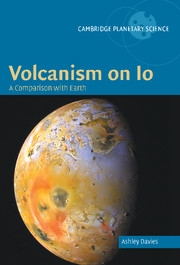Book contents
- Frontmatter
- Contents
- Preface
- List of Abbreviations
- Reproduction Permissions
- Introduction
- Section 1 Io, 1610 to 1995: Galileo to Galileo
- Section 2 Planetary volcanism: evolution and composition
- Section 3 Observing and modeling volcanic activity
- Section 4 Galileo at Io: the volcanic bestiary
- Section 5 Volcanism on Io: the global view
- 15 Geomorphology: paterae, shields, flows, and mountains
- 16 Volcanic plumes
- 17 Hot spots
- Section 6 Io after Galileo
- Appendix 1 Io hot-spot locations
- Appendix 2 Io maps
- References
- Index
- Plate Section
17 - Hot spots
Published online by Cambridge University Press: 05 October 2014
- Frontmatter
- Contents
- Preface
- List of Abbreviations
- Reproduction Permissions
- Introduction
- Section 1 Io, 1610 to 1995: Galileo to Galileo
- Section 2 Planetary volcanism: evolution and composition
- Section 3 Observing and modeling volcanic activity
- Section 4 Galileo at Io: the volcanic bestiary
- Section 5 Volcanism on Io: the global view
- 15 Geomorphology: paterae, shields, flows, and mountains
- 16 Volcanic plumes
- 17 Hot spots
- Section 6 Io after Galileo
- Appendix 1 Io hot-spot locations
- Appendix 2 Io maps
- References
- Index
- Plate Section
Summary
Using Galileo data, volcanic activity at individual volcanic centers was monitored and quantified on timescales of weeks to months, for a period of seven years. This monitoring was a huge step beyond the two snapshots of activity, four months apart, obtained by the Voyager spacecraft. Galileo's most exciting discovery was the large number of active volcanoes on Io, of which at least 50 had temperatures >1000 K (identified in Appendix 1). Having identified the locations of these high-temperature lavas, similar locations (e.g., dark-floored paterae; McEwen et al., 1985) were inferred also to be the result of silicate volcanism (see Chapter 9). By the end of the Galileo mission, more than 160 active hot spots had been identified from Voyager, Galileo, and Earth-based telescope data (see lists in Lopes et al. [2001, 2004]). In NIMS regional observations around Prometheus, where spatial resolution improved by a factor of 10 (Plate 7), the number of detected hot spots increased by a factor of ≈ 3 (Lopes et al., 2004), confirming earlier predictions that these small hot spots were present (Blaney et al., 1998, 2000). PPR detected many more low-temperature thermal sources not detectable by SSI or NIMS (Rathbun et al., 2004). Extrapolating to a global scale suggested as many as 300 large and small active hot spots on Io (Lopes et al., 2001), although the region covered by the aforementioned NIMS observation has a particularly high density of volcanic features (Schenk et al., 2001).
- Type
- Chapter
- Information
- Volcanism on IoA Comparison with Earth, pp. 269 - 284Publisher: Cambridge University PressPrint publication year: 2007

